Paper Menu >>
Journal Menu >>
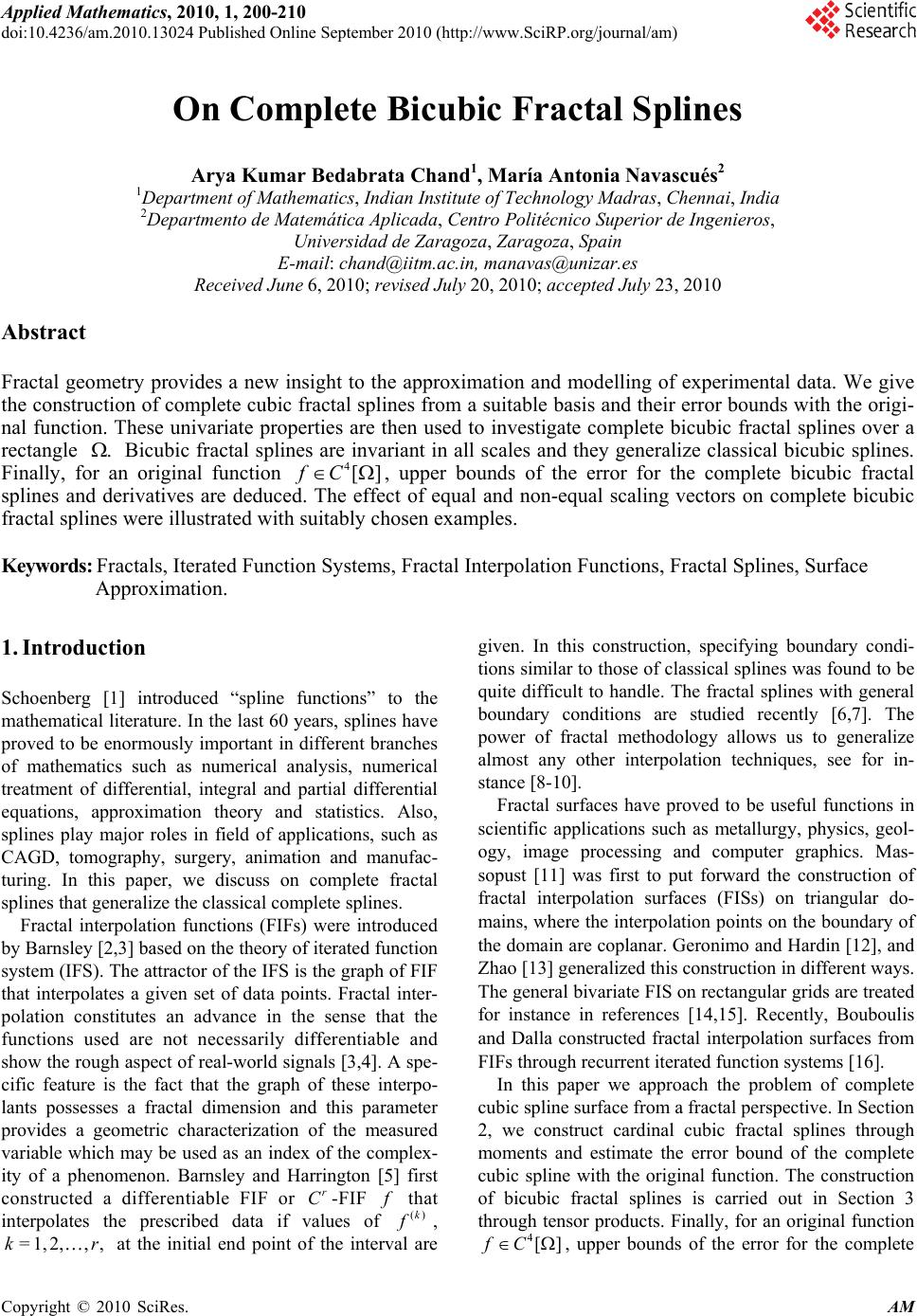 Applied Mathematics, 2010, 1, 200-210 doi:10.4236/am.2010.13024 Published Online September 2010 (http://www.SciRP.org/journal/am) Copyright © 2010 SciRes. AM On Complete Bicubic Fractal Splines Arya Kumar Bedabrata Chand1, María Antonia Navascués2 1Department of Mathematics, Indian Institute of Technology Madras, Chennai, India 2Departmento de Matemática Aplicada, Centro Politécnico Superior de Ingenieros, Universidad de Zaragoza, Zaragoza, Spain E-mail: chand@iitm.ac.in, manavas@unizar.es Received June 6, 2010; revised July 20, 2010; accepted July 23, 2010 Abstract Fractal geometry provides a new insight to the approximation and modelling of experimental data. We give the construction of complete cubic fractal splines from a suitable basis and their error bounds with the origi- nal function. These univariate properties are then used to investigate complete bicubic fractal splines over a rectangle . Bicubic fractal splines are invariant in all scales and they generalize classical bicubic splines. Finally, for an original function 4[]fC, upper bounds of the error for the complete bicubic fractal splines and derivatives are deduced. The effect of equal and non-equal scaling vectors on complete bicubic fractal splines were illustrated with suitably chosen examples. Keywords: Fractals, Iterated Function Systems, Fractal Interpolation Functions, Fractal Splines, Surface Approximation. 1. Introduction Schoenberg [1] introduced “spline functions” to the mathematical literature. In the last 60 years, splines have proved to be enormously important in different branches of mathematics such as numerical analysis, numerical treatment of differential, integral and partial differential equations, approximation theory and statistics. Also, splines play major roles in field of applications, such as CAGD, tomography, surgery, animation and manufac- turing. In this paper, we discuss on complete fractal splines that generalize the classical complete splines. Fractal interpolation functions (FIFs) were introduced by Barnsley [2,3] based on the theory of iterated function system (IFS). The attractor of the IFS is the graph of FIF that interpolates a given set of data points. Fractal inter- polation constitutes an advance in the sense that the functions used are not necessarily differentiable and show the rough aspect of real-world signals [3,4]. A spe- cific feature is the fact that the graph of these interpo- lants possesses a fractal dimension and this parameter provides a geometric characterization of the measured variable which may be used as an index of the complex- ity of a phenomenon. Barnsley and Harrington [5] first constructed a differentiable FIF or r C-FIF f that interpolates the prescribed data if values of ()k f , =1,2,, ,kr at the initial end point of the interval are given. In this construction, specifying boundary condi- tions similar to those of classical splines was found to be quite difficult to handle. The fractal splines with general boundary conditions are studied recently [6,7]. The power of fractal methodology allows us to generalize almost any other interpolation techniques, see for in- stance [8-10]. Fractal surfaces have proved to be useful functions in scientific applications such as metallurgy, physics, geol- ogy, image processing and computer graphics. Mas- sopust [11] was first to put forward the construction of fractal interpolation surfaces (FISs) on triangular do- mains, where the interpolation points on the boundary of the domain are coplanar. Geronimo and Hardin [12], and Zhao [13] generalized this construction in different ways. The general bivariate FIS on rectangular grids are treated for instance in references [14,15]. Recently, Bouboulis and Dalla constructed fractal interpolation surfaces from FIFs through recurrent iterated function systems [16]. In this paper we approach the problem of complete cubic spline surface from a fractal perspective. In Section 2, we construct cardinal cubic fractal splines through moments and estimate the error bound of the complete cubic spline with the original function. The construction of bicubic fractal splines is carried out in Section 3 through tensor products. Finally, for an original function 4[]fC , upper bounds of the error for the complete 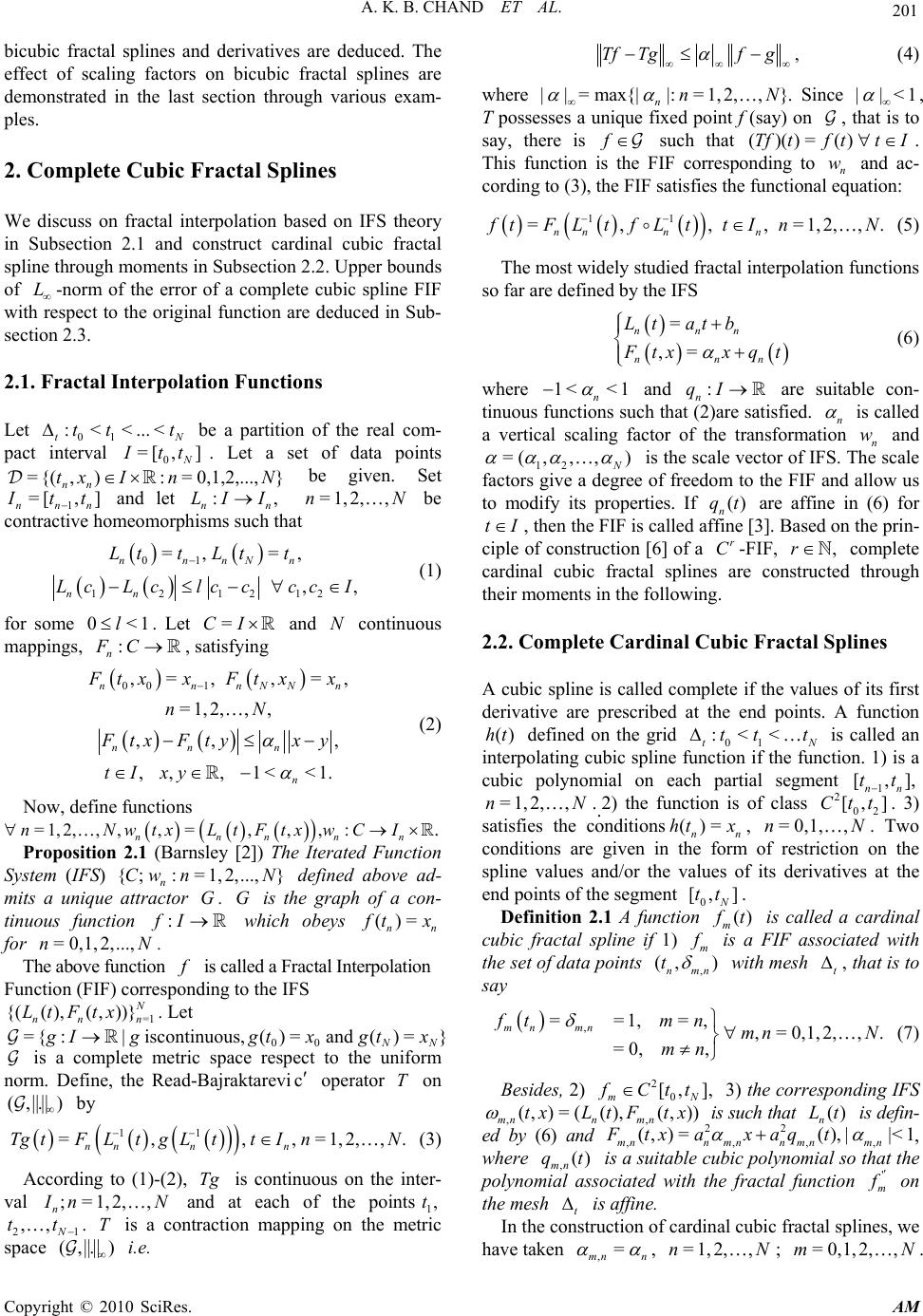 A. K. B. CHAND ET AL. Copyright © 2010 SciRes. AM 201 bicubic fractal splines and derivatives are deduced. The effect of scaling factors on bicubic fractal splines are demonstrated in the last section through various exam- ples. 2. Complete Cubic Fractal Splines We discuss on fractal interpolation based on IFS theory in Subsection 2.1 and construct cardinal cubic fractal spline through moments in Subsection 2.2. Upper bounds of L-norm of the error of a complete cubic spline FIF with respect to the original function are deduced in Sub- section 2.3. 2.1. Fractal Interpolation Functions Let 01 :<< ... < tN tt t be a partition of the real com- pact interval 0 =[ ,] N I tt . Let a set of data points }0,1,2,...,=:),{(= NnIxt nn be given. Set 1 =[, ] nnn I tt and let :, nn LI I =1,2, ,nN be contractive homeomorphisms such that 01 121212 =, =, ,, nnnNn nn Ltt Ltt LcLclccccI (1) for some 0<1l. Let =CI and N continuous mappings, : n FC, satisfying 00 1 ,= ,,=, =1,2,,, ,, , ,,, 1<<1. nnnNNn nn n n F txxFt xx nN F txF tyxy tI xy (2) Now, define functions =1,2,, ,,=,,,: nnnnn nNwtxLtFtxwCI . Proposition 2.1 (Barnsley [2]) The Iterated Function System (IFS) {;:= 1, 2,...,} n CwnN defined above ad- mits a unique attractor G. G is the graph of a con- tinuous function :fI which obeys ()= nn f tx for =0,1, 2,...,nN. The above function f is called a Fractal Interpolation Function (FIF) corresponding to the IFS =1 {((),( ,))} N nn n LtFtx . Let }=)(and=)(,usiscontinuo|:{=00NN xtgxtggIg is a complete metric space respect to the uniform norm. Define, the Read-Bajraktarevic operator T on ).,( by 11 =, ,,=1,2,,. nn nn TgtFL tgL tt InN (3) According to (1)-(2), Tg is continuous on the inter- val ;=1,2,, n I nN and at each of the points1,t 21 ,, N tt . T is a contraction mapping on the metric space ).,( i.e. ,Tf Tgfg (4) where ||=max{| |:=1,2,,} nnN . Since ||<1 , T possesses a unique fixed point f (say) on , that is to say, there is f such that ()()=()Tftf ttI . This function is the FIF corresponding to n w and ac- cording to (3), the FIF satisfies the functional equation: 11 =, ,,=1,2,,. nn nn f tFLtfLttInN (5) The most widely studied fractal interpolation functions so far are defined by the IFS = ,= nnn nnn Lt atb F txx q t (6) where 1< <1 n and : n qI are suitable con- tinuous functions such that (2)are satisfied. n is called a vertical scaling factor of the transformation n w and 12 =( ,,,) N is the scale vector of IFS. The scale factors give a degree of freedom to the FIF and allow us to modify its properties. If () n qt are affine in (6) for tI , then the FIF is called affine [3]. Based on the prin- ciple of construction [6] of a r C-FIF, ,r complete cardinal cubic fractal splines are constructed through their moments in the following. 2.2. Complete Cardinal Cubic Fractal Splines A cubic spline is called complete if the values of its first derivative are prescribed at the end points. A function ()ht defined on the grid 01 :<< tN tt t is called an interpolating cubic spline function if the function. 1) is a cubic polynomial on each partial segment 1 [,], nn tt =1,2, , nN..2) the function is of class 2 02 [, ]Ctt . 3) satisfies the conditions()= nn htx , =0,1,,nN. Two conditions are given in the form of restriction on the spline values and/or the values of its derivatives at the end points of the segment 0 [, ] N tt . Definition 2.1 A function () m f t is called a cardinal cubic fractal spline if 1) m f is a FIF associated with the set of data points , (, ) nmn t with mesh t , that is to say , ==1,=, ,=0,1, 2,,. =0, , mn mn ftmn mn N mn (7) Besides, 2) 2 0 [, ], mN f Ctt 3) the corresponding IFS ,, (, )=((),(, )) mnn mn txLtFtx is such that () n Lt is defin- ed by (6) and 22 ,,,, (, )=(),||<1 mnnmnn mnmn Ftxa xaqt , where ,() mn qt is a suitable cubic polynomial so that the polynomial associated with the fractal function ' m f on the mesh t is affine. In the construction of cardinal cubic fractal splines, we have taken ,= mn n , =1,2,,nN; =0,1,2,,mN. 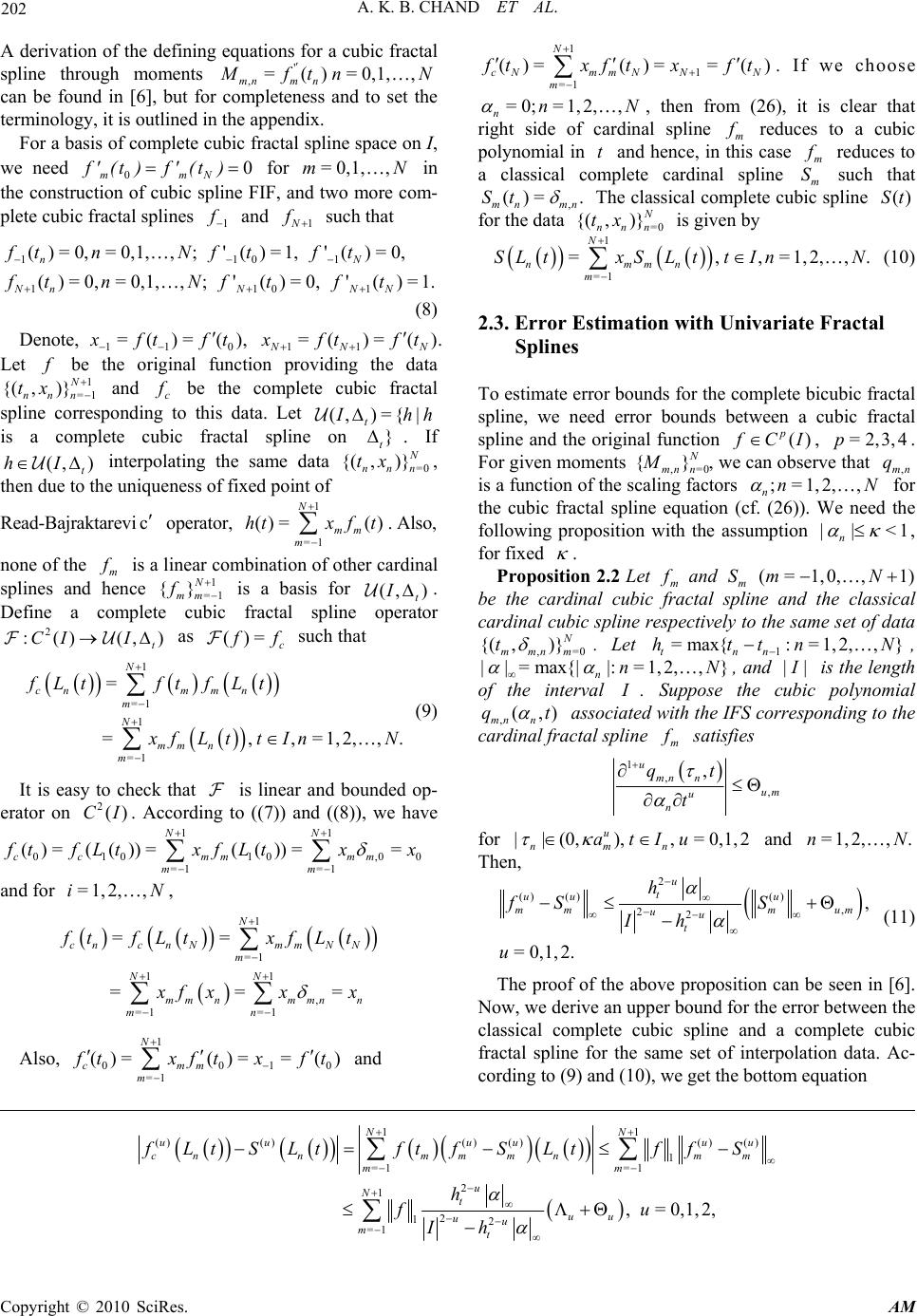 A. K. B. CHAND ET AL. Copyright © 2010 SciRes. AM 202 A derivation of the defining equations for a cubic fractal spline through moments ' ,=()=0,1,, mnm n M ftn N can be found in [6], but for completeness and to set the terminology, it is outlined in the appendix. For a basis of complete cubic fractal spline space on I, we need 00 mmN f' (t )f' (t) for =0,1, ,mN in the construction of cubic spline FIF, and two more com- plete cubic fractal splines 1 f and 1N f such that 1101 1101 () = 0,=0,1,,;'() =1,'() = 0, () = 0,=0,1,,;'() = 0,'()=1. nN NnN NN ft nNftft ftnNftf t (8) Denote, 11 0 =()= () x ftf t , 11 =()= () N NN x ftf t . Let f be the original function providing the data 1 =1 {( ,)}N nnn tx and c f be the complete cubic fractal spline corresponding to this data. Let hhI t|{=),( is a complete cubic fractal spline on } t . If ),( t Ih interpolating the same data =0 {( ,)} N nnn tx , then due to the uniqueness of fixed point of Read-Bajraktarevi c operator, 1 =1 ()= () N mm m htx ft . Also, none of the m f is a linear combination of other cardinal splines and hence 1 =1 {} N mm f is a basis for ),( t I . Define a complete cubic fractal spline operator ),()(:2 t IIC as c ff=)( such that 1 =1 1 =1 = =,,=1, 2,,. N cn mmn m N mm n m fLtftfLt x fLt tInN (9) It is easy to check that is linear and bounded op- erator on 2()CI. According to ((7)) and ((8)), we have 11 01010 ,00 =1 =1 ()=( ())=( ())== NN cc mm mm mm f tfLtxfLtx x and for =1,2, ,iN, 1 =1 11 , =1 =1 == === N cncnNmmN N m NN mm nmmnn mn f tfLtxfLt x fxx x Also, 1 0010 =1 ()=()== () N cmm m f txftxft and 1 1 =1 ()=()==() N cNmmN NN m f txftxft . If we choose =0;=1,2,, nnN , then from (26), it is clear that right side of cardinal spline m f reduces to a cubic polynomial in t and hence, in this case m f reduces to a classical complete cardinal spline m S such that , ()=. mn mn St The classical complete cubic spline ()St for the data =0 {( ,)} N nnn tx is given by 1 =1 =,,=1, 2,,. N nmmn m SL txSL ttInN (10) 2.3. Error Estimation with Univariate Fractal Splines To estimate error bounds for the complete bicubic fractal spline, we need error bounds between a cubic fractal spline and the original function () p f CI, =2,3,4p. For given moments ,= 0 {} N mn n M, we can observe that ,mn q is a function of the scaling factors ;=1,2, , nnN for the cubic fractal spline equation (cf. (26)). We need the following proposition with the assumption || <1 n , for fixed . Proposition 2.2 Let m f and m S (= 1,0,,1)mN be the cardinal cubic fractal spline and the classical cardinal cubic spline respectively to the same set of data ,=0 {( ,)}N mmnm t . Let 1 =max{: =1,2,, } tnn httnN , ||=max{| |:=1,2,,} nnN , and || I is the length of the interval I . Suppose the cubic polynomial ,(,) mn n qt associated with the IFS corresponding to the cardinal fractal spline m f satisfies 1 , , , u mn n um u n qt t for ||(0, ),,=0,1,2 u nmn atIu and =1,2,,.nN Then, 2 ()()() , 22, =0,1,2. u t uu u mmm um uu t h fS S Ih u (11) The proof of the above proposition can be seen in [6]. Now, we derive an upper bound for the error between the classical complete cubic spline and a complete cubic fractal spline for the same set of interpolation data. Ac- cording to (9) and (10), we get the bottom equation 11 ()()()()()() 1 =1 =1 2 1 2 12 =1 ,=0,1, 2, NN u uuuuu cnnmm mnm m mm u Nt uu uu mt fLtSLtftfSLtffS h fu Ih 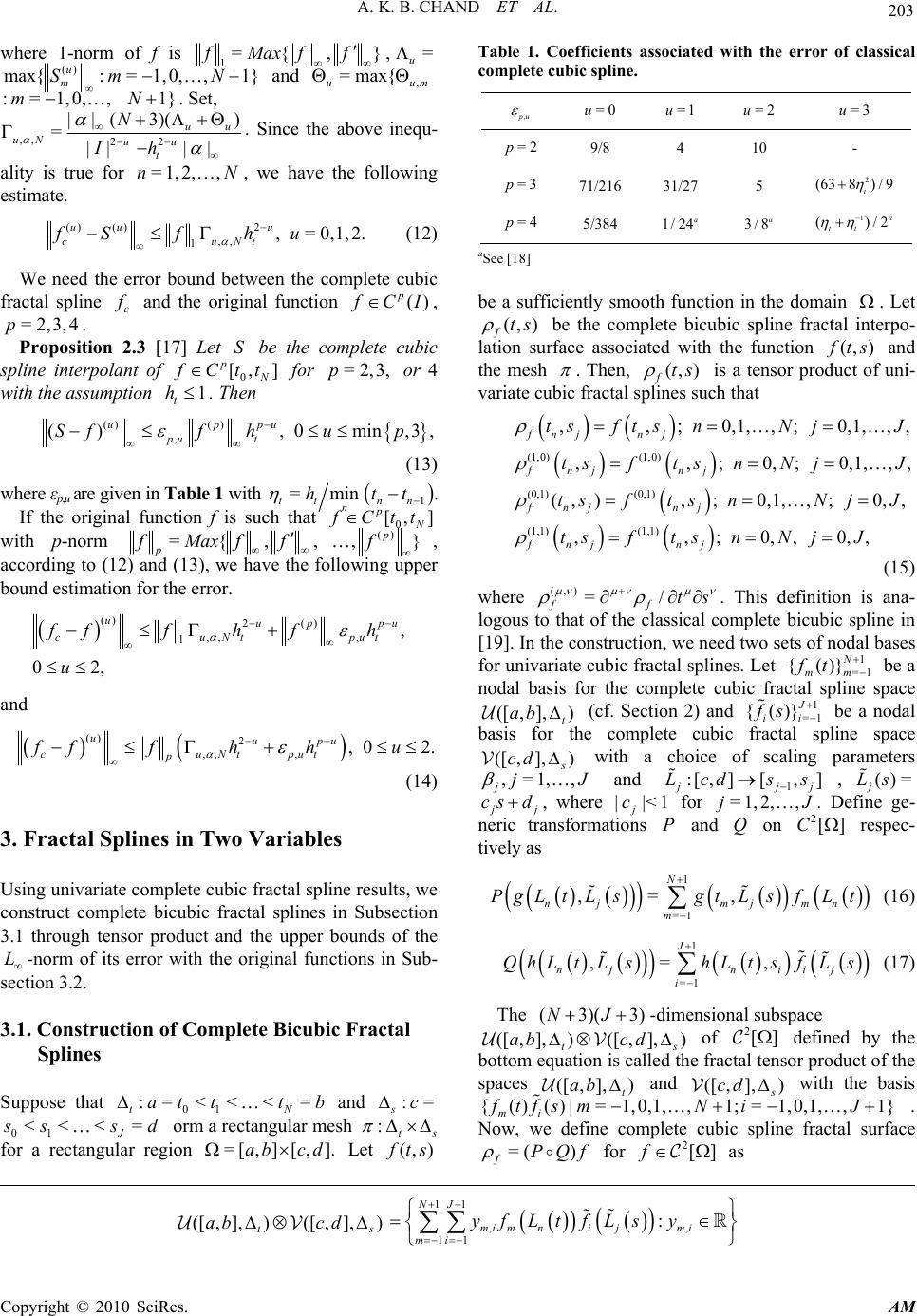 A. K. B. CHAND ET AL. Copyright © 2010 SciRes. AM 203 where 1-norm of f is 1={, }fMaxf f ,= u () max{:=1, 0,,1} u m Sm N and , =max{ uum :=1,0,,m 1}N. Set, ,, 22 ||( 3)() =||| | uu uN uu t N Ih . Since the above inequ- ality is true for =1,2,,nN , we have the following estimate. ()()2 ,, 1,=0,1, 2. uu u cuNt fSfhu (12) We need the error bound between the complete cubic fractal spline c f and the original function () p f CI, =2,3,4p. Proposition 2.3 [17] Let S be the complete cubic spline interpolant of 0 [,] p N f Ctt for =2,3,p or 4 with the assumption 1 t h. Then ()( ) , (),0min,3, uppu pu t Sff hup (13) where εp,u are given in Table 1 with 1 =min tt nn n htt . If the original function f is such that 0 [,] p N f Ctt with p-norm ={, , p fMaxff () ,} p f , according to (12) and (13), we have the following upper bound estimation for the error. () 2() ,, , 1, 02, uup pu cuNtput fffh fh u and () 2 ,,, ,02. uupu cuNtput p fffh hu (14) 3. Fractal Splines in Two Variables Using univariate complete cubic fractal spline results, we construct complete bicubic fractal splines in Subsection 3.1 through tensor product and the upper bounds of the L-norm of its error with the original functions in Sub- section 3.2. 3.1. Construction of Complete Bicubic Fractal Splines Suppose that 01 :=< <<= tN at ttb and := sc 01 << <= J s ssd orm a rectangular mesh :ts for a rectangular region =[,][ ,].ab cd Let (, ) f ts Table 1. Coefficients associated with the error of classical complete cubic spline. ,pu =0u =1u =2u =3u =2p 9/8 4 10 - =3p 71/216 31/27 5 2 (638) / 9 t =4 p 5/384 1/ 24a 3/8 a 1 ()/2 a tt aSee [18] be a sufficiently smooth function in the domain . Let (, ) fts be the complete bicubic spline fractal interpo- lation surface associated with the function (, ) f ts and the mesh . Then, (, ) fts is a tensor product of uni- variate cubic fractal splines such that (1,0) (1,0) (0,1) (0,1) (1,1) (1,1) , ,;0,1,,;0,1,,, ,,;0,;0,1,,, (,),;0,1,, ;0,, ,,;0,,0,, fnj nj fnj nj fnj nj fnj nj tsftsnN jJ tsftsnN jJ tsftsnN jJ tsftsnNjJ (15) where (,) =/ ff ts . This definition is ana- logous to that of the classical complete bicubic spline in [19]. In the construction, we need two sets of nodal bases for univariate cubic fractal splines. Let 1 =1 {()} N mm ft be a nodal basis for the complete cubic fractal spline space )],,([t ba (cf. Section 2) and 1 =1 {()} J ii fs be a nodal basis for the complete cubic fractal spline space )],,([ s dc with a choice of scaling parameters ,=1,, jjJ and 1 :[ ,][,] j jj Lcdss ,()= j Ls j j csd , where ||<1 j c for =1,2, ,jJ. Define ge- neric transformations P and Q on 2[]C respec- tively as 1 =1 ,= , N nj mjmn m PgLtLsgtLsfLt (16) 1 =1 ,= , J nj niij i QhLt L shLtsfL s (17) The (3)(3)NJ -dimensional subspace )],,([)],,([ st dcba of ][ 2 defined by the bottom equation is called the fractal tensor product of the spaces )],,([t ba and )],,([ s dc with the basis { ()()|=1,0,1, ,1;=1,0,1, ,1} mi ftfsmNiJ . Now, we define complete cubic spline fractal surface =( ) fPQf for ][ 2 f as )],,([)],,([ st dcba 11 ,, 11 : NJ mi mnijmi mi yfLtfLs y 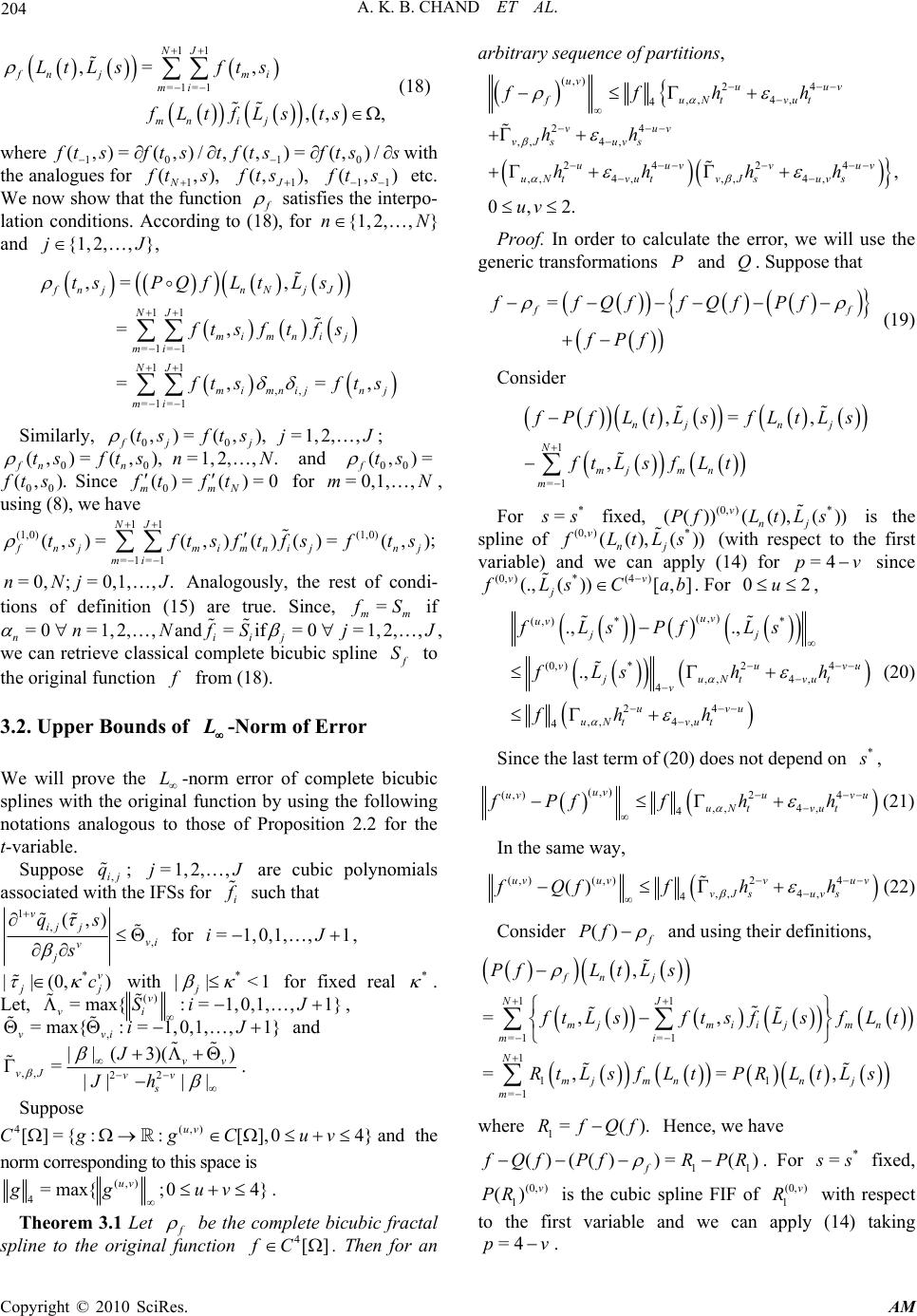 A. K. B. CHAND ET AL. Copyright © 2010 SciRes. AM 204 11 =1=1 ,=, ,, , NJ fn jmi mi mnij LtLs fts fLtfLs ts (18) where10 10 (,)= (,)/,(,)=(,)/ f tsft stftsftss with the analogues for 1 (,), N f ts 1 (, ), J fts 11 (, ) f ts etc. We now show that the function f satisfies the interpo- lation conditions. According to (18), for {1, 2,,}nN and {1, 2,,},jJ 11 =1=1 11 ,, =1=1 ,= , =, =,=, fnjnNjJ NJ mimnij mi NJ mimnijn j mi tsPQf LtLs ftsftf s f ts fts Similarly, 00 (, )= (,),=1,2,, fj j tsfts jJ ; 00 (, )= (, ),=1,2,,. fn n tsfts nN and 00 (, )= fts 00 (, ) f ts. Since 0 ()=( )=0 mmN ftft for =0,1,,mN, using (8), we have 11 (1,0) (1,0) =1=1 (, )=(,)()()=(, ) NJ f njmimnij nj mi tsft sf tfsfts ; =0,;=0,1,, .nNj J Analogously, the rest of condi- tions of definition (15) are true. Since, = mm f S if =0=1,2, , nnN and = ii f S if=0=1,2, , jjJ , we can retrieve classical complete bicubic spline f S to the original function f from (18). 3.2. Upper Bounds of L-Norm of Error We will prove the L-norm error of complete bicubic splines with the original function by using the following notations analogous to those of Proposition 2.2 for the t-variable. Suppose ,ij q ; =1,2, ,jJ are cubic polynomials associated with the IFSs for i f such that 1 , , (,) v ij j vi v j qs s for =1,0,1,,1iJ , * ||(0, ) v j j c with * || <1 j for fixed real * . Let, () =max{: =1,0,1,,1} v vi Si J , , =max{:=1,0,1,,1} vvi iJ and ,, 22 ||(3)() =|| || vv vJ vv s J Jh . Suppose 4(,) []={::[],04} uv Cg gCuvand the norm corresponding to this space is (,) 4=max{ ;04} uv gguv . Theorem 3.1 Let f be the complete bicubic fractal spline to the original function 4[]fC. Then for an arbitrary sequence of partitions, (,) 24 ,,4 , 4 24 ,,4 , 24 24 ,,4 ,,,4 ,, 0,2. uv uuv fuNtvut vuv vJs uvs uuv vuv uNtvutvJs uvs ffhh hh hh hh uv Proof. In order to calculate the error, we will use the generic transformations P and Q. Suppose that = ff ffQffQfPf fPf (19) Consider 1 =1 ,=, , nj nj N mj mn m f PfL tL sfL tLs ftLsfL t For * = s s fixed, (0, )* (())((),( )) v nj PfL tLs is the spline of (0,)* ((),()) v nj f LtLs (with respect to the first variable) and we can apply (14) for =4pv since (0, )*(4) (.,())[ ,] vv j f LsC ab . For 02u, (,) (,) ** (0, )*24 ,,4 , 4 24 ,,4 , 4 ., ., ., uv uv jj vuvu juNtvut v uvu uNtvut fLsPf Ls fLsh h fh h (20) Since the last term of (20) does not depend on * s , (,) (,)2 4 ,,4 , 4 uv uvuvu uNtvut fPff hh (21) In the same way, (,) (,)24 ,,4 , 4 () uvuvvu v vJs uvs fQff hh (22) Consider () f Pf and using their definitions, 11 =1 =1 1 11 =1 , =, , =,= , fn j NJ mjmii jmn mi N mjmnn j m PfLtLs f tLsftsfLsf Lt RtLsfLtPRL tL s where 1=().RfQf Hence, we have 11 () (())=() f f QfPfR PR . For * = s s fixed, (0, ) 1 () v PR is the cubic spline FIF of (0, ) 1 v R with respect to the first variable and we can apply (14) taking =4pv . 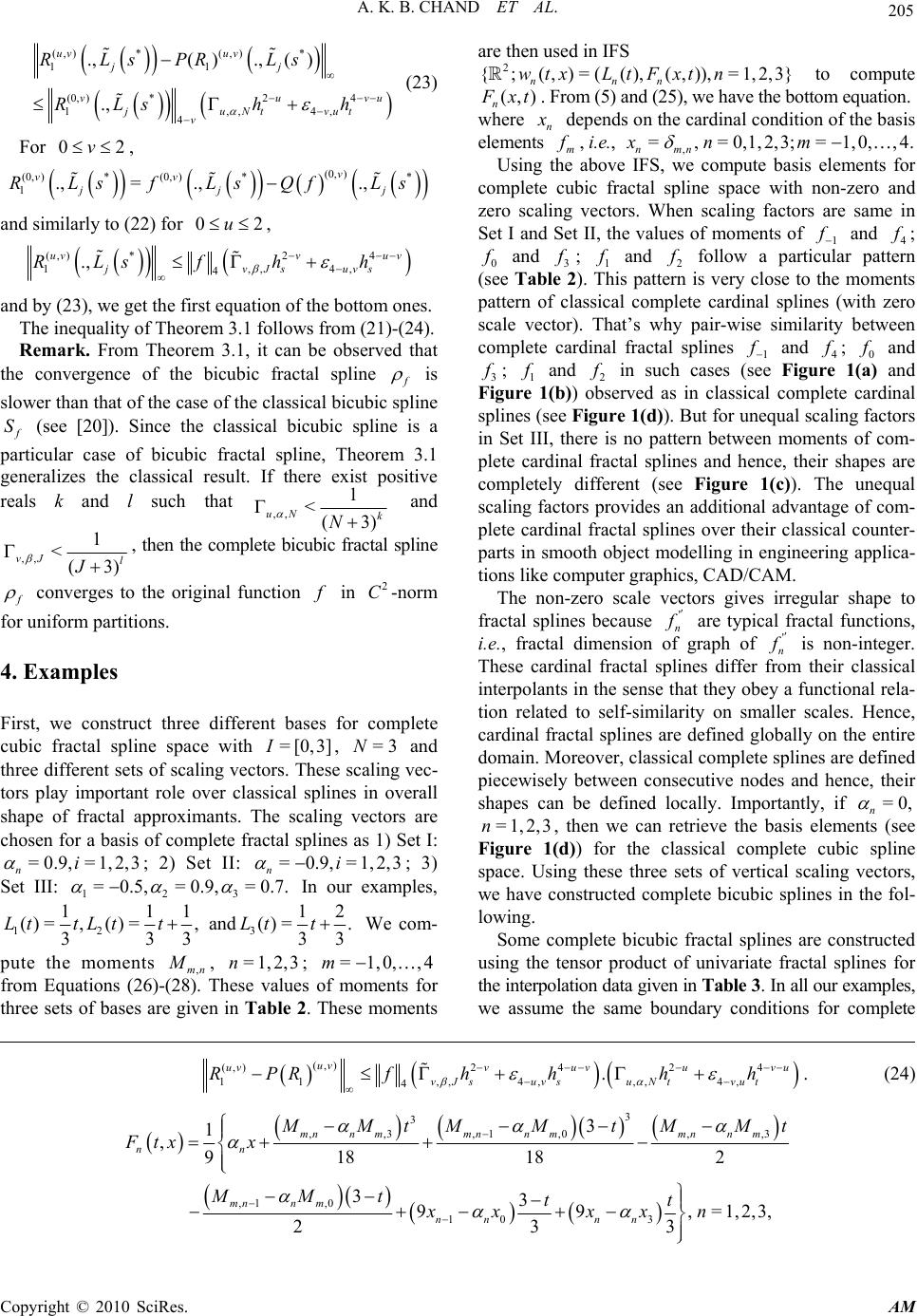 A. K. B. CHAND ET AL. Copyright © 2010 SciRes. AM 205 (,)*(,)* 11 (0, )*24 1,,4, 4 .,().,( ) ., uv uv jj vuvu juNtvut v RLsPR Ls RLsh h (23) For 02v, (0, ) (0, )*(0, )** 1.,= .,., v vv jj j RLsf LsQfLs and similarly to (22) for 02u, (,) *24 1,,4, 4 ., uvvu v jvJsuvs RLs fhh and by (23), we get the first equation of the bottom ones. The inequality of Theorem 3.1 follows from (21)-(24). Remark. From Theorem 3.1, it can be observed that the convergence of the bicubic fractal spline f is slower than that of the case of the classical bicubic spline f S (see [20]). Since the classical bicubic spline is a particular case of bicubic fractal spline, Theorem 3.1 generalizes the classical result. If there exist positive reals k and l such that ,, 1 < ( 3 ) uN k N and ,, 1 < ( 3 ) vJ l J , then the complete bicubic fractal spline f converges to the original function f in 2 C-norm for uniform partitions. 4. Examples First, we construct three different bases for complete cubic fractal spline space with =[0,3]I, =3N and three different sets of scaling vectors. These scaling vec- tors play important role over classical splines in overall shape of fractal approximants. The scaling vectors are chosen for a basis of complete fractal splines as 1) Set I: =0.9,= 1, 2,3 ni ; 2) Set II: =0.9,= 1, 2,3 ni ; 3) Set III: 123 =0.5,= 0.9,= 0.7. In our examples, 12 111 ()=,()=, 333 Lt tLt t and 3 12 ()= . 33 Lt t We com- pute the moments ,mn M, =1,2,3n; =1,0, ,4m from Equations (26)-(28). These values of moments for three sets of bases are given in Table 2. These moments are then used in IFS 2 {;(,)=((),(,)),= 1, 2,3} nnn wtxLtFxt n to compute (,) n F xt . From (5) and (25), we have the bottom equation. where n x depends on the cardinal condition of the basis elements m f , i.e., , =,=0,1, 2,3;=1,0,,4 nmn xn m . Using the above IFS, we compute basis elements for complete cubic fractal spline space with non-zero and zero scaling vectors. When scaling factors are same in Set I and Set II, the values of moments of 1 f and 4 f ; 0 f and 3 f ; 1 f and 2 f follow a particular pattern (see Table 2). This pattern is very close to the moments pattern of classical complete cardinal splines (with zero scale vector). That’s why pair-wise similarity between complete cardinal fractal splines 1 f and 4 f ; 0 f and 3 f ; 1 f and 2 f in such cases (see Figure 1(a) and Figure 1(b)) observed as in classical complete cardinal splines (see Figure 1(d)). But for unequal scaling factors in Set III, there is no pattern between moments of com- plete cardinal fractal splines and hence, their shapes are completely different (see Figure 1(c)). The unequal scaling factors provides an additional advantage of com- plete cardinal fractal splines over their classical counter- parts in smooth object modelling in engineering applica- tions like computer graphics, CAD/CAM. The non-zero scale vectors gives irregular shape to fractal splines because ' n f are typical fractal functions, i.e., fractal dimension of graph of ' n f is non-integer. These cardinal fractal splines differ from their classical interpolants in the sense that they obey a functional rela- tion related to self-similarity on smaller scales. Hence, cardinal fractal splines are defined globally on the entire domain. Moreover, classical complete splines are defined piecewisely between consecutive nodes and hence, their shapes can be defined locally. Importantly, if =0, n =1,2,3n, then we can retrieve the basis elements (see Figure 1(d)) for the classical complete cubic spline space. Using these three sets of vertical scaling vectors, we have constructed complete bicubic splines in the fol- lowing. Some complete bicubic fractal splines are constructed using the tensor product of univariate fractal splines for the interpolation data given in Table 3. In all our examples, we assume the same boundary conditions for complete (,) (,)2 424 11,,4, ,,4, 4. uv uvvuvuv u vJs uvsuNtvut RPRf hhhh . (24) 3 3 ,,3,1,0,,3 ,1 ,0 10 3 3 1 ,918 182 33 99,=1, 2,3, 233 mnn mmnn mmnn m nn mnnm nn nn M Mt MMtMMt Ftxx MMt tt xx xxn 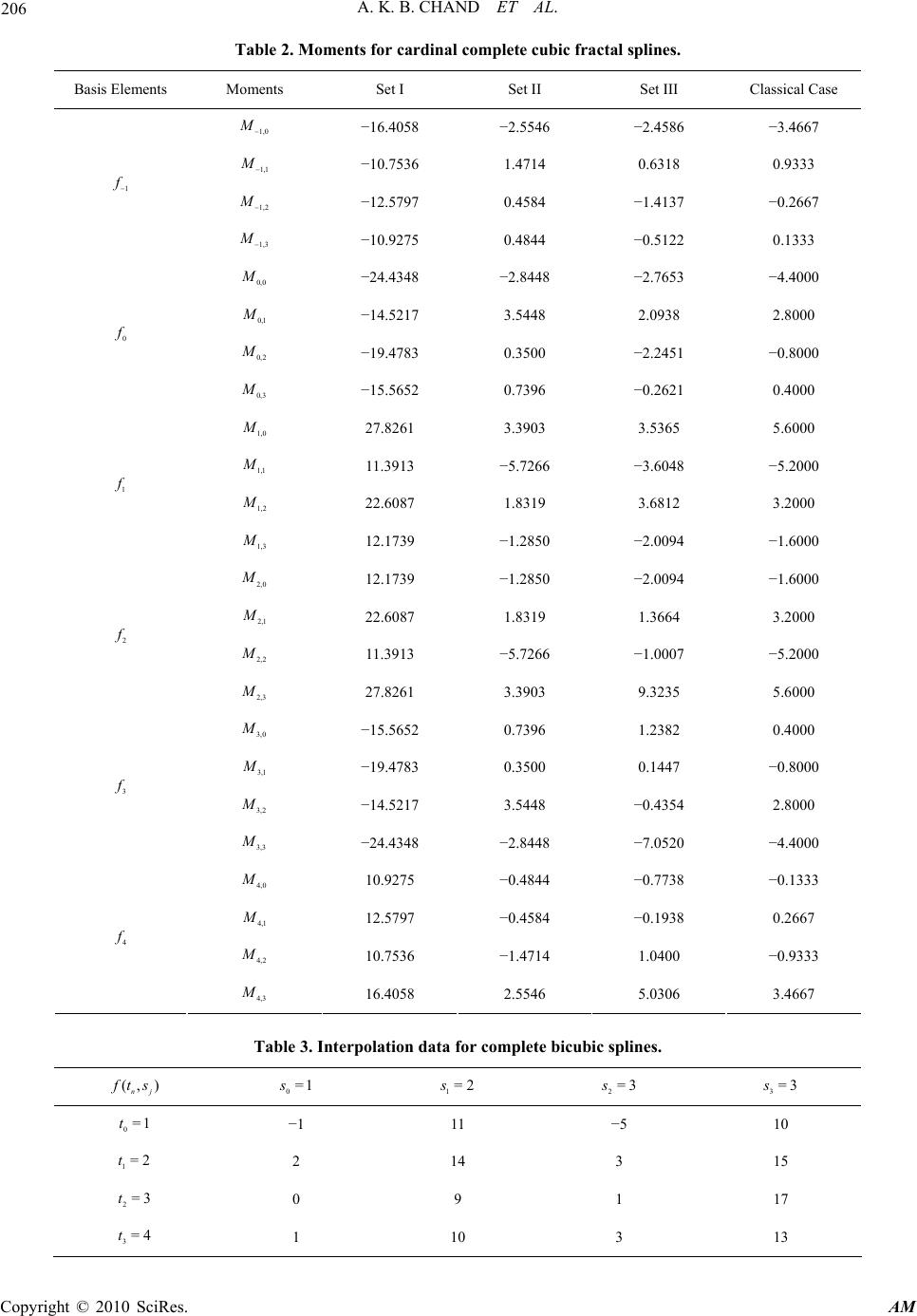 A. K. B. CHAND ET AL. Copyright © 2010 SciRes. AM 206 Table 2. Moments for cardinal complete cubic fractal splines. Basis Elements Moments Set I Set II Set III Classical Case 1,0 M −16.4058 −2.5546 −2.4586 −3.4667 1,1 M −10.7536 1.4714 0.6318 0.9333 1,2 M −12.5797 0.4584 −1.4137 −0.2667 1 f 1,3 M −10.9275 0.4844 −0.5122 0.1333 0,0 M −24.4348 −2.8448 −2.7653 −4.4000 0,1 M −14.5217 3.5448 2.0938 2.8000 0,2 M −19.4783 0.3500 −2.2451 −0.8000 0 f 0,3 M −15.5652 0.7396 −0.2621 0.4000 1,0 M 27.8261 3.3903 3.5365 5.6000 1,1 M 11.3913 −5.7266 −3.6048 −5.2000 1,2 M 22.6087 1.8319 3.6812 3.2000 1 f 1,3 M 12.1739 −1.2850 −2.0094 −1.6000 2,0 M 12.1739 −1.2850 −2.0094 −1.6000 2,1 M 22.6087 1.8319 1.3664 3.2000 2,2 M 11.3913 −5.7266 −1.0007 −5.2000 2 f 2,3 M 27.8261 3.3903 9.3235 5.6000 3,0 M −15.5652 0.7396 1.2382 0.4000 3,1 M −19.4783 0.3500 0.1447 −0.8000 3,2 M −14.5217 3.5448 −0.4354 2.8000 3 f 3,3 M −24.4348 −2.8448 −7.0520 −4.4000 4,0 M 10.9275 −0.4844 −0.7738 −0.1333 4,1 M 12.5797 −0.4584 −0.1938 0.2667 4,2 M 10.7536 −1.4714 1.0400 −0.9333 4 f 4,3 M 16.4058 2.5546 5.0306 3.4667 Table 3. Interpolation data for complete bicubic splines. (, ) nj f ts 0=1s 1=2s 2=3s 3=3s 0=1t −1 11 −5 10 1=2t 2 14 3 15 2=3t 0 9 1 17 3=4t 1 10 3 13 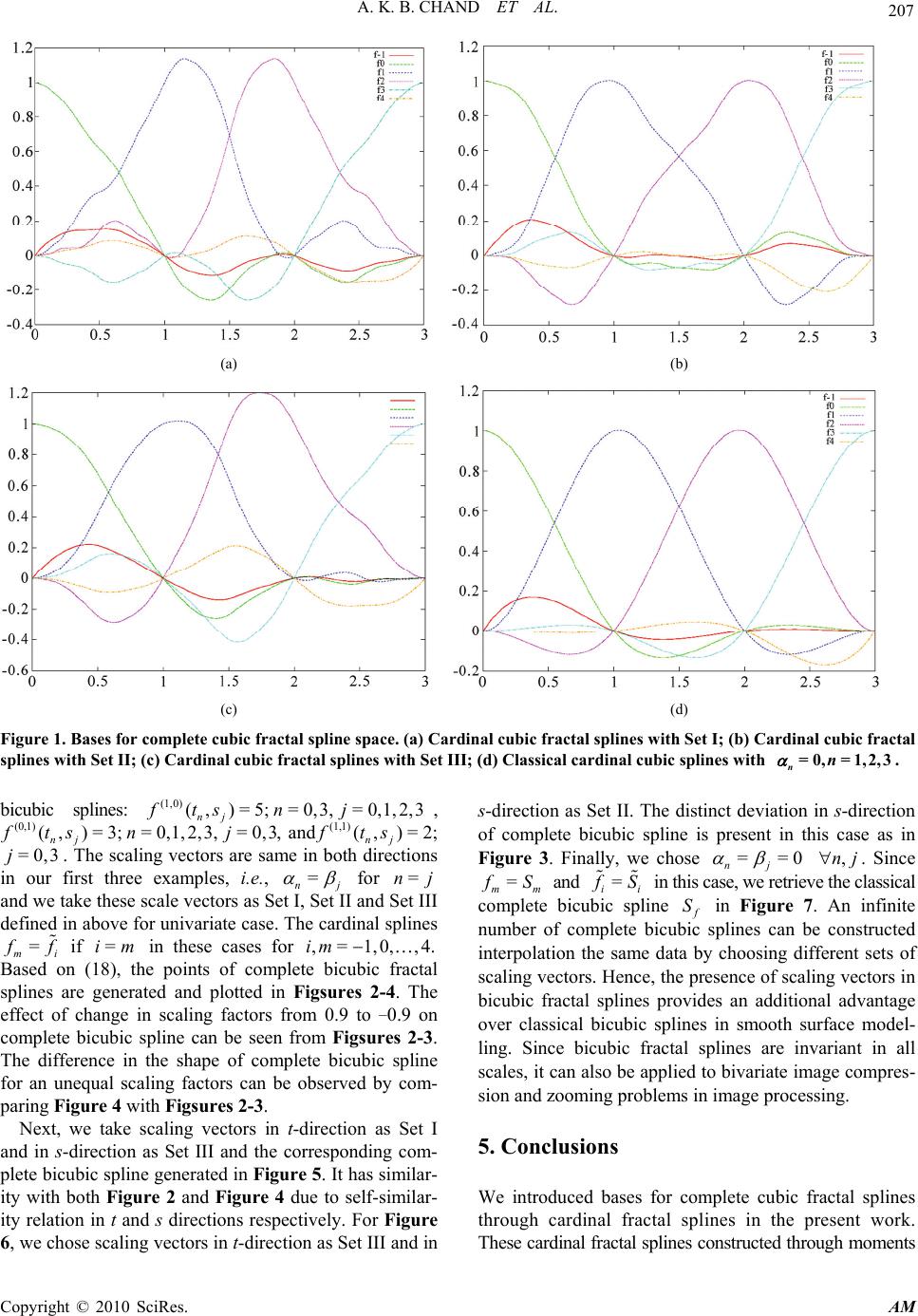 A. K. B. CHAND ET AL. Copyright © 2010 SciRes. AM 207 (a) (b) (c) (d) Figure 1. Bases for complete cubic fractal spline space. (a) Cardinal cubic fractal splines with Set I; (b) Cardinal cubic fractal splines with Set II; (c) Cardinal cubic fractal splines with Set III; (d) Classical cardinal cubic splines with =0,=1,2,3 nn . bicubic splines: (1,0) (,) = 5;= 0,3,= 0,1,2,3 nj fts nj, (0,1) (,)=3; =0,1,2,3, =0,3 nj ftsnj, and(1,1)(,)=2 nj fts; =0,3j. The scaling vectors are same in both directions in our first three examples, i.e., = nj for =nj and we take these scale vectors as Set I, Set II and Set III defined in above for univariate case. The cardinal splines = mi f f if =im in these cases for ,=1,0,,4.im Based on (18), the points of complete bicubic fractal splines are generated and plotted in Figsures 2-4. The effect of change in scaling factors from 0.9 to −0.9 on complete bicubic spline can be seen from Figsures 2-3. The difference in the shape of complete bicubic spline for an unequal scaling factors can be observed by com- paring Figure 4 with Figsures 2-3. Next, we take scaling vectors in t-direction as Set I and in s-direction as Set III and the corresponding com- plete bicubic spline generated in Figure 5. It has similar- ity with both Figure 2 and Figure 4 due to self-similar- ity relation in t and s directions respectively. For Figure 6, we chose scaling vectors in t-direction as Set III and in s-direction as Set II. The distinct deviation in s-direction of complete bicubic spline is present in this case as in Figure 3. Finally, we chose ==0 nj ,nj. Since = mm fS and = ii f S in this case, we retrieve the classical complete bicubic spline f S in Figure 7. An infinite number of complete bicubic splines can be constructed interpolation the same data by choosing different sets of scaling vectors. Hence, the presence of scaling vectors in bicubic fractal splines provides an additional advantage over classical bicubic splines in smooth surface model- ling. Since bicubic fractal splines are invariant in all scales, it can also be applied to bivariate image compres- sion and zooming problems in image processing. 5. Conclusions We introduced bases for complete cubic fractal splines through cardinal fractal splines in the present work. These cardinal fractal splines constructed through moments 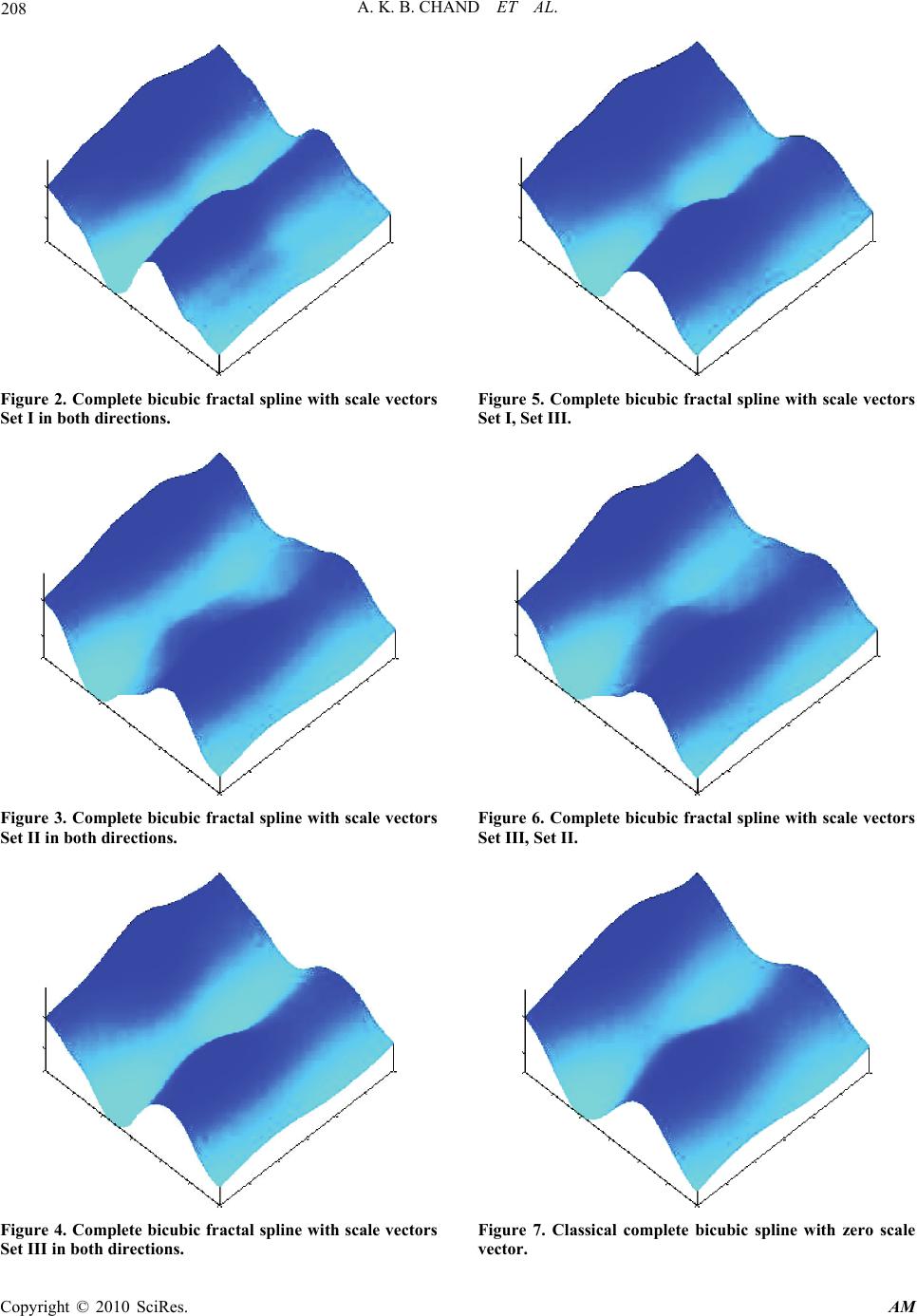 A. K. B. CHAND ET AL. Copyright © 2010 SciRes. AM 208 Figure 2. Complete bicubic fractal spline with scale vectors Set I in both directions. Figure 3. Complete bicubic fractal spline with scale vectors Set II in both directions. Figure 4. Complete bicubic fractal spline with scale vectors Set III in both directions. Figure 5. Complete bicubic fractal spline with scale vectors Set I, Set III. Figure 6. Complete bicubic fractal spline with scale vectors Set III, Set II. Figure 7. Classical complete bicubic spline with zero scale vector. 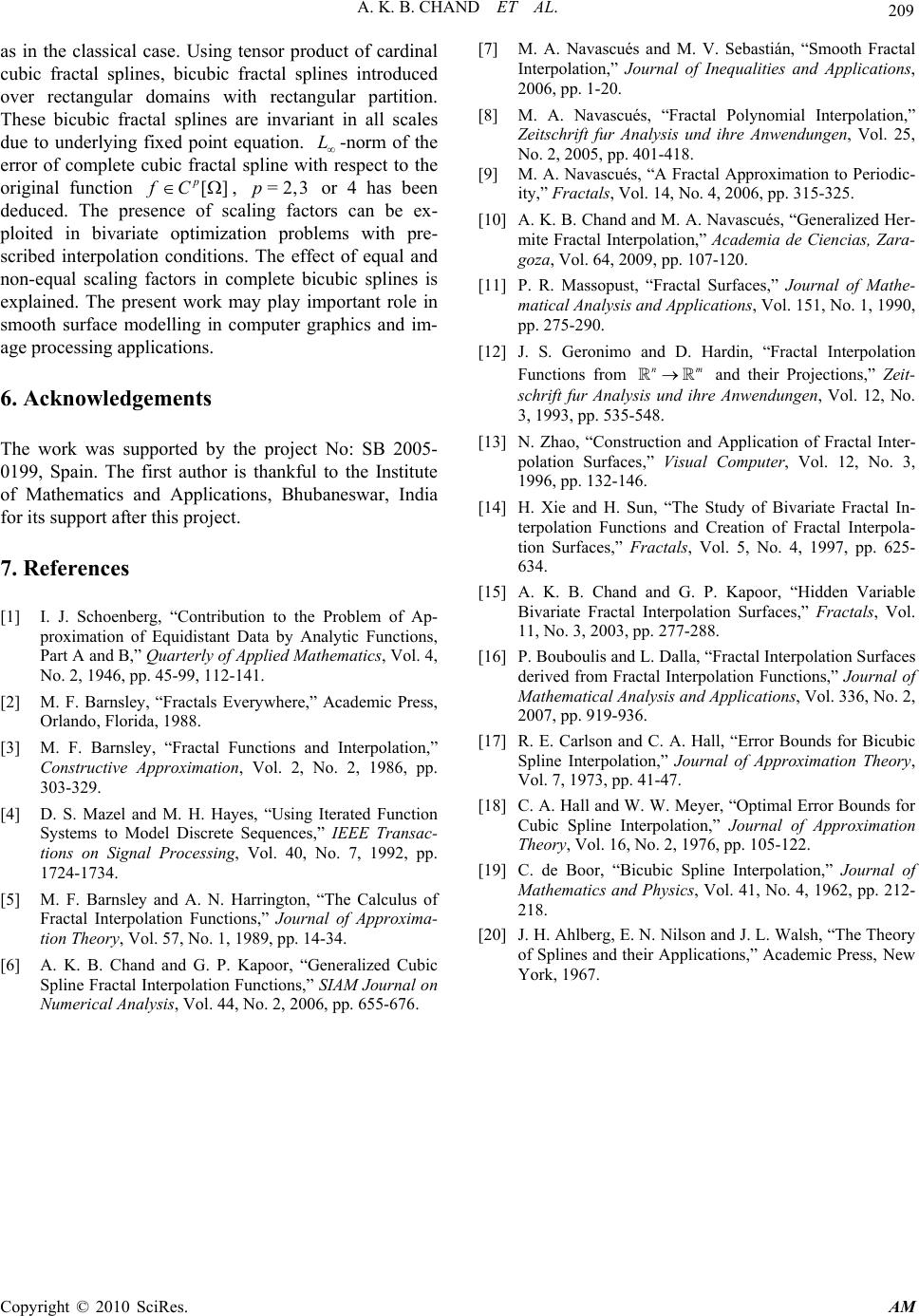 A. K. B. CHAND ET AL. Copyright © 2010 SciRes. AM 209 as in the classical case. Using tensor product of cardinal cubic fractal splines, bicubic fractal splines introduced over rectangular domains with rectangular partition. These bicubic fractal splines are invariant in all scales due to underlying fixed point equation. L-norm of the error of complete cubic fractal spline with respect to the original function [] p fC , =2,3p or 4 has been deduced. The presence of scaling factors can be ex- ploited in bivariate optimization problems with pre- scribed interpolation conditions. The effect of equal and non-equal scaling factors in complete bicubic splines is explained. The present work may play important role in smooth surface modelling in computer graphics and im- age processing applications. 6. Acknowledgements The work was supported by the project No: SB 2005- 0199, Spain. The first author is thankful to the Institute of Mathematics and Applications, Bhubaneswar, India for its support after this project. 7. References [1] I. J. Schoenberg, “Contribution to the Problem of Ap- proximation of Equidistant Data by Analytic Functions, Part A and B,” Quarterly of Applied Mathematics, Vol. 4, No. 2, 1946, pp. 45-99, 112-141. [2] M. F. Barnsley, “Fractals Everywhere,” Academic Press, Orlando, Florida, 1988. [3] M. F. Barnsley, “Fractal Functions and Interpolation,” Constructive Approximation, Vol. 2, No. 2, 1986, pp. 303-329. [4] D. S. Mazel and M. H. Hayes, “Using Iterated Function Systems to Model Discrete Sequences,” IEEE Transac- tions on Signal Processing, Vol. 40, No. 7, 1992, pp. 1724-1734. [5] M. F. Barnsley and A. N. Harrington, “The Calculus of Fractal Interpolation Functions,” Journal of Approxima- tion Theory, Vol. 57, No. 1, 1989, pp. 14-34. [6] A. K. B. Chand and G. P. Kapoor, “Generalized Cubic Spline Fractal Interpolation Functions,” SIAM Journal on Numerical Analysis, Vol. 44, No. 2, 2006, pp. 655-676. [7] M. A. Navascués and M. V. Sebastián, “Smooth Fractal Interpolation,” Journal of Inequalities and Applications, 2006, pp. 1-20. [8] M. A. Navascués, “Fractal Polynomial Interpolation,” Zeitschrift fur Analysis und ihre Anwendungen, Vol. 25, No. 2, 2005, pp. 401-418. [9] M. A. Navascués, “A Fractal Approximation to Periodic- ity,” Fractals, Vol. 14, No. 4, 2006, pp. 315-325. [10] A. K. B. Chand and M. A. Navascués, “Generalized Her- mite Fractal Interpolation,” Academia de Ciencias, Zara- goza, Vol. 64, 2009, pp. 107-120. [11] P. R. Massopust, “Fractal Surfaces,” Journal of Mathe- matical Analysis and Applications, Vol. 151, No. 1, 1990, pp. 275-290. [12] J. S. Geronimo and D. Hardin, “Fractal Interpolation Functions from nm and their Projections,” Zeit- schrift fur Analysis und ihre Anwendungen, Vol. 12, No. 3, 1993, pp. 535-548. [13] N. Zhao, “Construction and Application of Fractal Inter- polation Surfaces,” Visual Computer, Vol. 12, No. 3, 1996, pp. 132-146. [14] H. Xie and H. Sun, “The Study of Bivariate Fractal In- terpolation Functions and Creation of Fractal Interpola- tion Surfaces,” Fractals, Vol. 5, No. 4, 1997, pp. 625- 634. [15] A. K. B. Chand and G. P. Kapoor, “Hidden Variable Bivariate Fractal Interpolation Surfaces,” Fractals, Vol. 11, No. 3, 2003, pp. 277-288. [16] P. Bouboulis and L. Dalla, “Fractal Interpolation Surfaces derived from Fractal Interpolation Functions,” Journal of Mathematical Analysis and Applications, Vol. 336, No. 2, 2007, pp. 919-936. [17] R. E. Carlson and C. A. Hall, “Error Bounds for Bicubic Spline Interpolation,” Journal of Approximation Theory, Vol. 7, 1973, pp. 41-47. [18] C. A. Hall and W. W. Meyer, “Optimal Error Bounds for Cubic Spline Interpolation,” Journal of Approximation Theory, Vol. 16, No. 2, 1976, pp. 105-122. [19] C. de Boor, “Bicubic Spline Interpolation,” Journal of Mathematics and Physics, Vol. 41, No. 4, 1962, pp. 212- 218. [20] J. H. Ahlberg, E. N. Nilson and J. L. Walsh, “The Theory of Splines and their Applications,” Academic Press, New York, 1967. 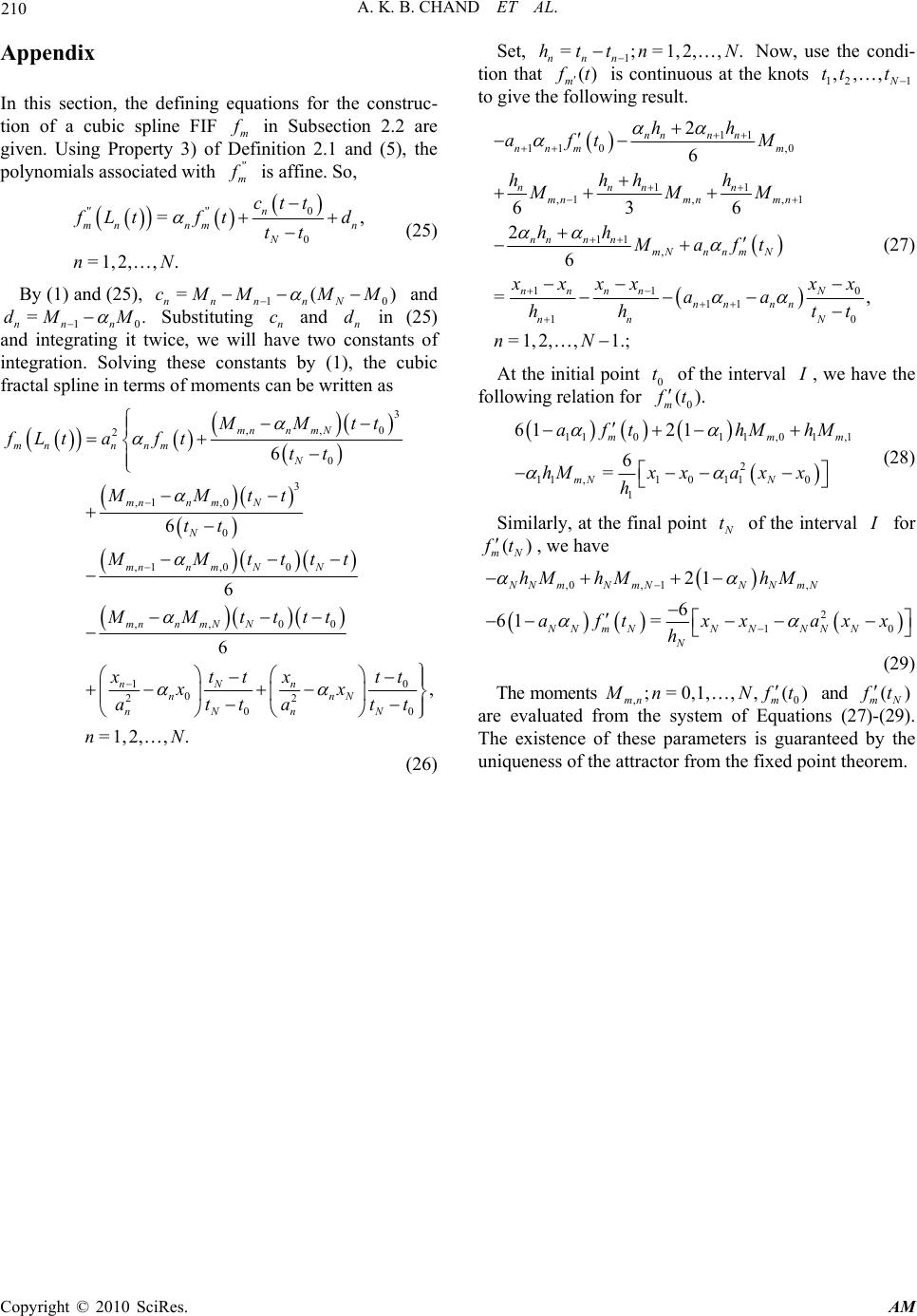 A. K. B. CHAND ET AL. Copyright © 2010 SciRes. AM 210 Appendix In this section, the defining equations for the construc- tion of a cubic spline FIF m f in Subsection 2.2 are given. Using Property 3) of Definition 2.1 and (5), the polynomials associated with ' m f is affine. So, 0 '' 0 =, =1,2,,. n mn nmn N ctt fLt ftd tt nN (25) By (1) and (25), 10 =() nnn nN cMMM M and 10 =. nn n dMM Substituting n c and n d in (25) and integrating it twice, we will have two constants of integration. Solving these constants by (1), the cubic fractal spline in terms of moments can be written as 3 ,,0 2 0 3 ,1 ,0 0 ,1,00 ,,00 10 0 22 00 6 6 6 6 , =1,2,,. mnnmN mnn nm N mnn mN N mnn mNN mnnmNN nNn nnN NN nn MMtt fLtafttt MMtt tt MMtttt MMtttt xttxtt xx tt tt aa nN (26) Set, 1 =;=1,2,,. nnn httn N Now, use the condi- tion that () m ft is continuous at the knots 12 1 ,, , N tt t to give the following result. 11 11 0,0 11 ,1, ,1 11 , 11 0 11 10 2 6 636 2 6 =, =1,2, ,1.; nnnn nnm m nnnn mnmn mn nnn n mNnn mN nnnn N nn nn nn N hh aft M hhh h MMM hh Maft x xxx xx aa hh tt nN (27) At the initial point 0 t of the interval I , we have the following relation for 0 (). m f t 1101 1,01,1 2 11 ,1 0110 1 61 21 6 = mmm mN N afthM hM hMxxaxx h (28) Similarly, at the final point N t of the interval I for () mN f t , we have ,0, 1, 2 10 21 6 61 = NNmN mNNN mN NNm NNNNNN N hMhMhM aftxx axx h (29) The moments ,;=0,1,, mn M nN,0 () m ft and () mN ft are evaluated from the system of Equations (27)-(29). The existence of these parameters is guaranteed by the uniqueness of the attractor from the fixed point theorem. |

